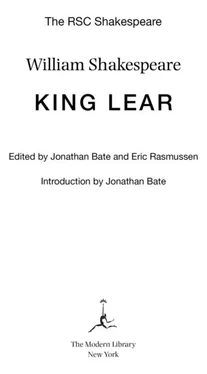уильям шекспир - King Lear
Здесь есть возможность читать онлайн «уильям шекспир - King Lear» весь текст электронной книги совершенно бесплатно (целиком полную версию без сокращений). В некоторых случаях можно слушать аудио, скачать через торрент в формате fb2 и присутствует краткое содержание. Год выпуска: 2011, ISBN: 2011, Издательство: Random House Publishing Group, Жанр: Старинная литература, на английском языке. Описание произведения, (предисловие) а так же отзывы посетителей доступны на портале библиотеки ЛибКат.
- Название:King Lear
- Автор:
- Издательство:Random House Publishing Group
- Жанр:
- Год:2011
- ISBN:978-1-58836-828-7
- Рейтинг книги:3 / 5. Голосов: 1
-
Избранное:Добавить в избранное
- Отзывы:
-
Ваша оценка:
- 60
- 1
- 2
- 3
- 4
- 5
King Lear: краткое содержание, описание и аннотация
Предлагаем к чтению аннотацию, описание, краткое содержание или предисловие (зависит от того, что написал сам автор книги «King Lear»). Если вы не нашли необходимую информацию о книге — напишите в комментариях, мы постараемся отыскать её.
King Lear — читать онлайн бесплатно полную книгу (весь текст) целиком
Ниже представлен текст книги, разбитый по страницам. Система сохранения места последней прочитанной страницы, позволяет с удобством читать онлайн бесплатно книгу «King Lear», без необходимости каждый раз заново искать на чём Вы остановились. Поставьте закладку, и сможете в любой момент перейти на страницу, на которой закончили чтение.
Интервал:
Закладка:
As the costumes appealed to the eyes, so there was music for the ears. Comedies included many songs. Desdemona’s willow song, perhaps a late addition to the text, is a rare and thus exceptionally poignant example from tragedy. Trumpets and tuckets sounded for ceremonial entrances, drums denoted an army on the march. Background music could create atmosphere, as at the beginning of Twelfth Night , during the lovers’ dialogue near the end of The Merchant of Venice , when the statue seemingly comes to life in The Winter’s Tale , and for the revival of Pericles and of Lear (in the Quarto text, but not the Folio). The haunting sound of the hautboy suggested a realm beyond the human, as when the god Hercules is imagined deserting Mark Antony. Dances symbolized the harmony of the end of a comedy—though in Shakespeare’s world of mingled joy and sorrow, someone is usually left out of the circle.
The most important resource was, of course, the actors themselves. They needed many skills: in the words of one contemporary commentator, “dancing, activity, music, song, elocution, ability of body, memory, skill of weapon, pregnancy of wit.” Their bodies were as significant as their voices. Hamlet tells the player to “suit the action to the word, the word to the action”: moments of strong emotion, known as “passions,” relied on a repertoire of dramatic gestures as well as a modulation of the voice. When Titus Andronicus has had his hand chopped off, he asks, “How can I grace my talk, / Wanting a hand to give it action?” A pen portrait of “The Character of an Excellent Actor” by the dramatist John Webster is almost certainly based on his impression of Shakespeare’s leading man, Richard Burbage: “By a full and significant action of body, he charms our attention: sit in a full theatre, and you will think you see so many lines drawn from the circumference of so many ears, whiles the actor is the centre.…”
Though Burbage was admired above all others, praise was also heaped upon the apprentice players whose alto voices fitted them for the parts of women. A spectator at Oxford in 1610 records how the audience was reduced to tears by the pathos of Desdemona’s death. The puritans who fumed about the biblical prohibition upon cross-dressing and the encouragement to sodomy constituted by the sight of an adult male kissing a teenage boy on stage were a small minority. Little is known, however, about the characteristics of the leading apprentices in Shakespeare’s company. It may perhaps be inferred that one was a lot taller than the other, since Shakespeare often wrote for a pair of female friends, one tall and fair, the other short and dark (Helena and Hermia, Rosalind and Celia, Beatrice and Hero).
We know little about Shakespeare’s own acting roles—an early allusion indicates that he often took royal parts, and a venerable tradition gives him old Adam in As You Like It and the ghost of old King Hamlet. Save for Burbage’s lead roles and the generic part of the clown, all such castings are mere speculation. We do not even know for sure whether the original Falstaff was Will Kempe or another actor who specialized in comic roles, Thomas Pope.
Kempe left the company in early 1599. Tradition has it that he fell out with Shakespeare over the matter of excessive improvisation. He was replaced by Robert Armin, who was less of a clown and more of a cerebral wit: this explains the difference between such parts as Lancelet Gobbo and Dogberry, which were written for Kempe, and the more verbally sophisticated Feste and Lear’s Fool, which were written for Armin.
One thing that is clear from surviving “plots” or storyboards of plays from the period is that a degree of doubling was necessary. 2 Henry VI has more than sixty speaking parts, but more than half of the characters only appear in a single scene and most scenes have only six to eight speakers. At a stretch, the play could be performed by thirteen actors. When Thomas Platter saw Julius Caesar at the Globe in 1599, he noted that there were about fifteen. Why doesn’t Paris go to the Capulet ball in Romeo and Juliet? Perhaps because he was doubled with Mercutio, who does. In The Winter’s Tale , Mamillius might have come back as Perdita and Antigonus been doubled by Camillo, making the partnership with Paulina at the end a very neat touch. Titania and Oberon are often played by the same pair as Hippolyta and Theseus, suggesting a symbolic matching of the rulers of the worlds of night and day, but it is questionable whether there would have been time for the necessary costume changes. As so often, one is left in a realm of tantalizing speculation.
THE KING’S MAN
The new king, James I, who had held the Scottish throne as James VI since he had been an infant, immediately took the Lord Chamberlain’s Men under his direct patronage. Henceforth they would be the King’s Men, and for the rest of Shakespeare’s career they were favored with far more court performances than any of their rivals. There even seem to have been rumors early in the reign that Shakespeare and Burbage were being considered for knighthoods, an unprecedented honor for mere actors—and one that in the event was not accorded to a member of the profession for nearly three hundred years, when the title was bestowed upon Henry Irving, the leading Shakespearean actor of Queen Victoria’s reign.
Shakespeare’s productivity rate slowed in the Jacobean years, not because of age or some personal trauma, but because there were frequent outbreaks of plague, causing the theaters to be closed for long periods. The King’s Men were forced to spend many months on the road. Between November 1603 and 1608, they were to be found at various towns in the south and Midlands, though Shakespeare probably did not tour with them by this time. He had bought a large house back home in Stratford and was accumulating other property. He may indeed have stopped acting soon after the new king took the throne. With the London theaters closed so much of the time and a large repertoire on the stocks, Shakespeare seems to have focused his energies on writing a few long and complex tragedies that could have been played on demand at court: Othello, King Lear, Antony and Cleopatra, Coriolanus , and Cymbeline are among his longest and poetically grandest plays. Macbeth only survives in a shorter text, which shows signs of adaptation after Shakespeare’s death. The bitterly satirical Timon of Athens , apparently a collaboration with Thomas Middleton that may have failed on the stage, also belongs to this period. In comedy, too, he wrote longer and morally darker works than in the Elizabethan period, pushing at the very bounds of the form in Measure for Measure and All’s Well That Ends Well .
From 1608 onward, when the King’s Men began occupying the indoor Blackfriars playhouse (as a winter house, meaning that they only used the outdoor Globe in summer?), Shakespeare turned to a more romantic style. His company had a great success with a revived and altered version of an old pastoral play called Mucedorus . It even featured a bear. The younger dramatist John Fletcher, meanwhile, sometimes working in collaboration with Francis Beaumont, was pioneering a new style of tragicomedy, a mix of romance and royalism laced with intrigue and pastoral excursions. Shakespeare experimented with this idiom in Cymbeline and it was presumably with his blessing that Fletcher eventually took over as the King’s Men’s company dramatist. The two writers apparently collaborated on three plays in the years 1612–14: a lost romance called Cardenio (based on the love-madness of a character in Cervantes’ Don Quixote ), Henry VIII (originally staged with the title “All Is True”), and The Two Noble Kinsmen , a dramatization of Chaucer’s “Knight’s Tale.” These were written after Shakespeare’s two final solo-authored plays, The Winter’s Tale , a self-consciously old-fashioned work dramatizing the pastoral romance of his old enemy Robert Greene, and The Tempest , which at one and the same time drew together multiple theatrical traditions, diverse reading, and contemporary interest in the fate of a ship that had been wrecked on the way to the New World.
Читать дальшеИнтервал:
Закладка:
Похожие книги на «King Lear»
Представляем Вашему вниманию похожие книги на «King Lear» списком для выбора. Мы отобрали схожую по названию и смыслу литературу в надежде предоставить читателям больше вариантов отыскать новые, интересные, ещё непрочитанные произведения.
Обсуждение, отзывы о книге «King Lear» и просто собственные мнения читателей. Оставьте ваши комментарии, напишите, что Вы думаете о произведении, его смысле или главных героях. Укажите что конкретно понравилось, а что нет, и почему Вы так считаете.












